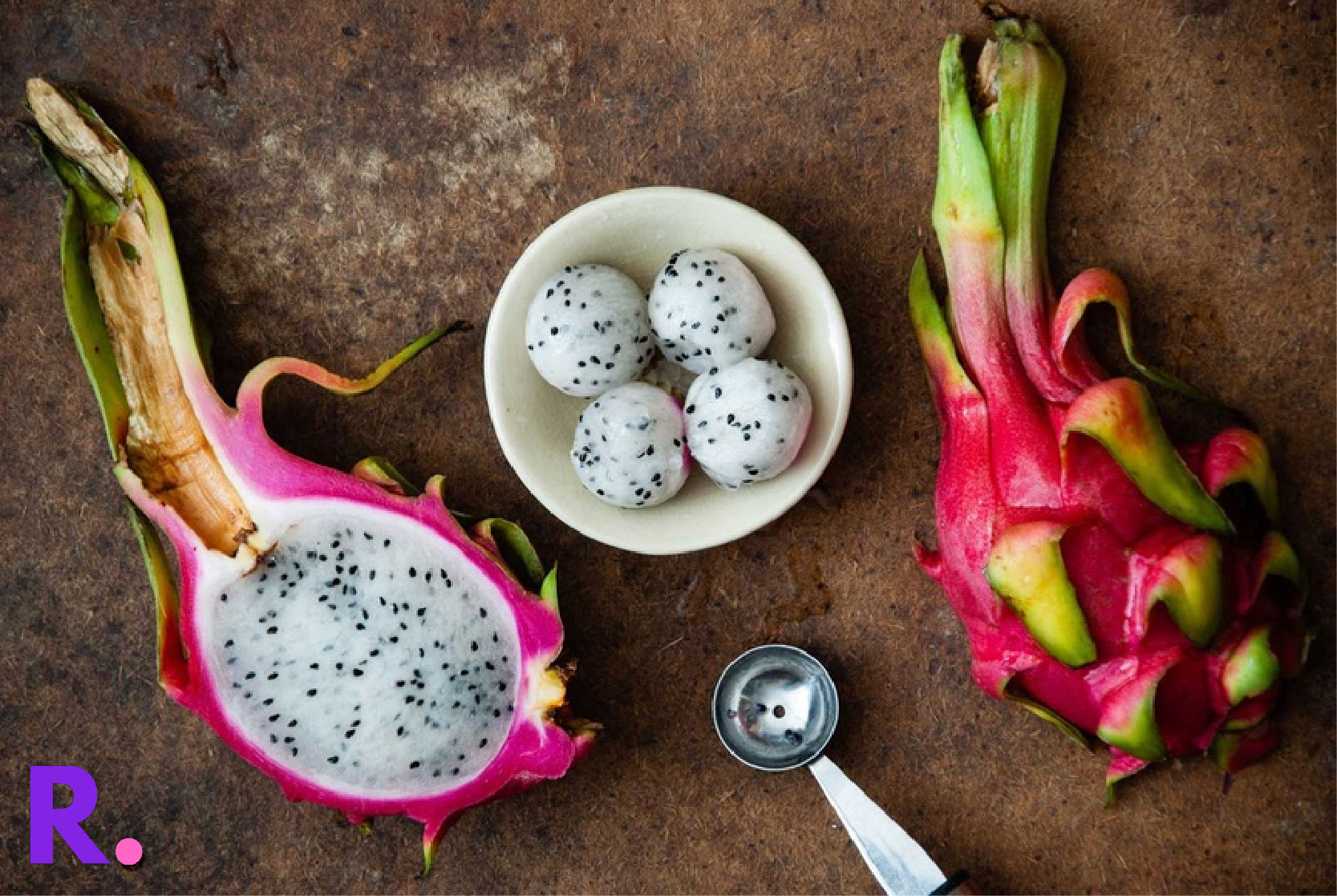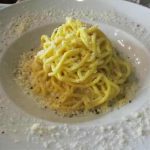Dragon fruits have become popular recently because of their vibrant colors and unique appearance. The white dragon fruit stands out with its striking appearance and delicious taste. This guide explores the white dragonfruit, its pink counterpart, dragon fruit season, peeling the fruit, where to buy it, and more.
What is White Dragon Fruit?
White Dragon Fruit is a tropical fruit in the cactus family. It is also called pitaya blanca or Hylocereus undatus. The skin is white or yellowish with greenish scales. The flesh is sweet-tasting and filled with tiny black seeds. The taste combines kiwi and pear for a delightful mix of sweetness and acidity.

Pink Dragon Fruit: A Close Relative
Pink Dragon Fruit vs. White Dragon Fruit
Hylocereus cactus produces pink and white dragon fruits. Their skin and flesh colors are the main differences. Pink dragon fruit (Pitaya roja or Hylocereus costaricensis) features brilliant pink or red flesh with black seeds, unlike white dragonfruit. Pink dragon fruit tastes sweeter and is more bright and colorful than white.
You can also read The Pink Dragonfruit: Taste, Benefits, and Yummy Recipe!
Nutritional Comparison
Let’s take a look at a nutritional breakdown to see how these two varieties compare:
White Dragon Fruit (per 100g):
- Calories: 60
- Carbs: 9g
- Fiber: 1.9g
- Protein: 1.5g
- Vitamin C: 9mg (15% DV)
- Calcium: 8mg (1% DV)
- Iron: 0.9mg (5% DV)
Pink Dragon Fruit (per 100g):
- Calories: 60
- Carbs: 9g
- Fiber: 1.5g
- Protein: 1.5g
- Vitamin C: 9mg (15% DV)
- Calcium: 9mg (1% DV)
- Iron: 1mg (6% DV)
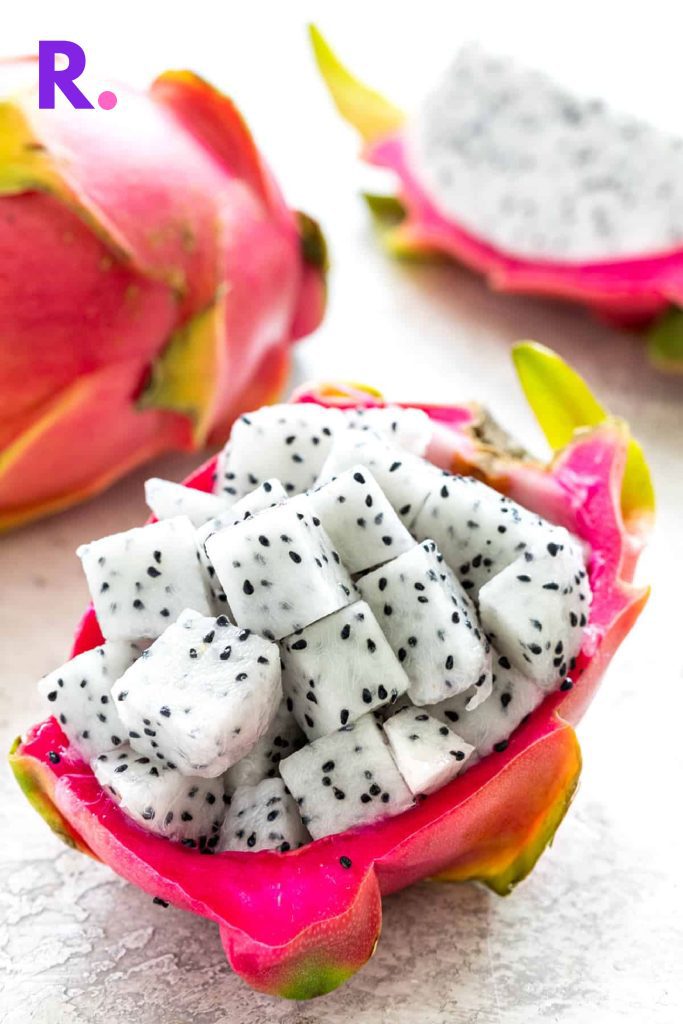
What Sets White Dragon Fruit Apart?
- Milder Flavor: Less sweet than pink dragon fruit, making it a great addition in sweet and savory cuisines.
- Low Calories: White dragonfruit is a great low-calorie fruit option.
- Refreshing Texture: The flesh complements various recipes as it is super refreshing.
White Dragon Fruit: A Visual Delight
Appearance and Varieties
This fruit is beautiful with white or yellow skin and green scales. White meat with tiny black seeds is protected by thin, strong skin. Eating the seeds gives the fruit a delicious crunch. The white flesh and black seeds contrast beautifully, making the fruit more appealing.
Nutritional Value
White dragon fruit is visually appealing and super nutritious!
- Its vitamin C content boosts immunity and skin health.
- Fiber-rich fruit aids digestion and regulates blood sugar.
- Betalanin and other antioxidants fight oxidative stress and inflammation.
- B vitamins are best for energy and cellular functions.
- It also contains calcium and iron for bone health and red blood cell development.
Pink Fruits: A Spectrum of Tastes
Pink dragon fruit has several flavours and health advantages. Watermelon, guava, pink grapefruit, raspberry, and strawberry are some popular pink fruits.
- Watermelon hydrates and contains vitamins A and C.
- Vitamin C, fiber, and antioxidants are abundant in guava.
- Pink grapefruit has potassium, fiber, and vitamin C.
- Raspberries are antioxidant-rich and heart-healthy.
- Delicious strawberries have vitamin C, fiber, and antioxidants.
- Lycopene and anthocyanin are found in pink fruits.
Their overall benefits include heart disease prevention, cancer prevention, skin health, digestion, and weight management. Choose to eat pink fruits for these numerous health!
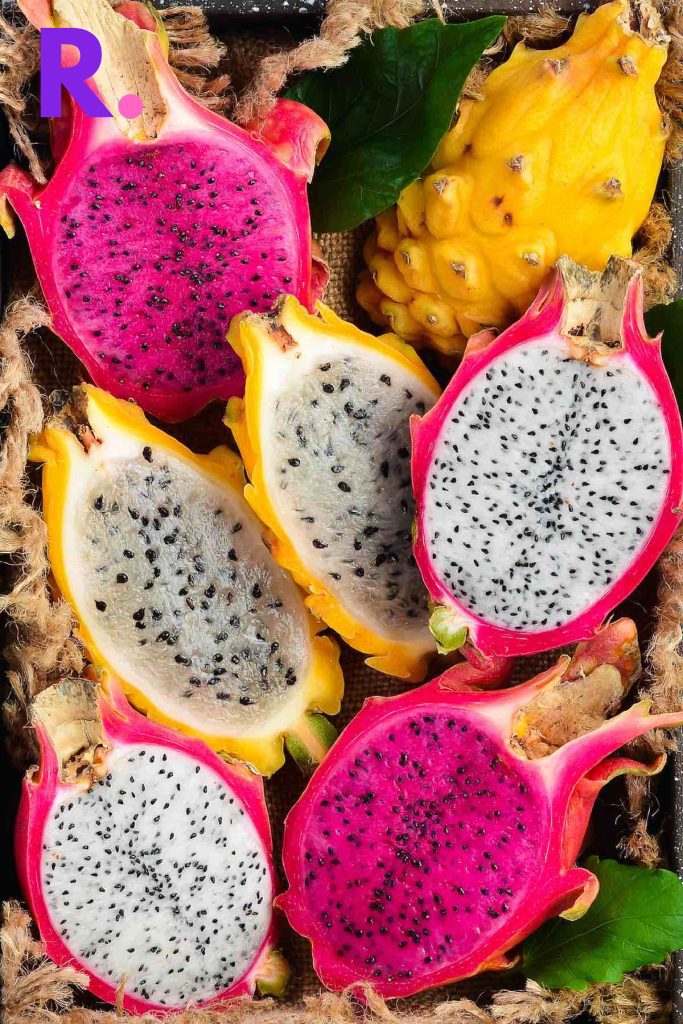
Dragon Fruit Season: When to Enjoy Them Best
Understanding the Seasonality
Dragon fruit, both white and pink, grows seasonally according on climate and location. Dragon fruit grows year-round in tropical locations. However, understanding dragon fruit seasons can help individuals in non-tropical regions or seeking fresher fruits:
- Summer to Early Fall: The Dragon fruit season in tropical climates normally spans late spring to early autumn. Fresh dragon fruits are abundant in local marketplaces and supermarkets during this time.
- Late Fall to Early Spring: In non-tropical countries, dragon fruit availability may be limited in late autumn and winter. Dragon fruits may be imported; however, they may not be fresh or available.
Picture of Dragon Fruit: Unveiling the Beauty
Visual Appeal of Dragon Fruit
Dragon fruit’s beauty is very fascinating. Dragon fruit images typically look like this:
- Dragon fruit exteriors are decorated with vibrant colors. White dragon fruit has white or yellow skin and green scales.
- Dragon fruit has clean white/pink flesh with maybe tiny black seeds when cut open. White/pink flesh and black seeds make a striking contrast.
- Dragon fruits are commonly served in many ways, such as sliced rounds, cubed, or carved into various shapes. Their attractive look makes them ideal for decorations and fruit dishes.
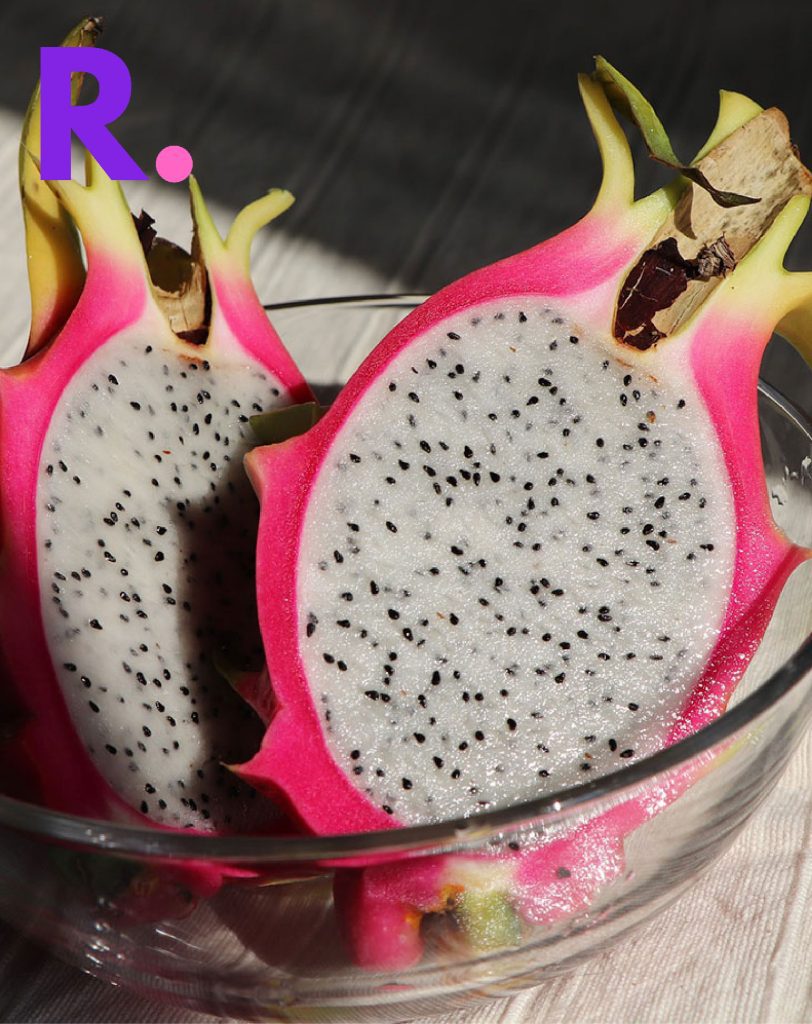
Buying Dragon Fruit: Tips and Tricks
Where to Find Dragon Fruit
There are numerous dragon fruit shopping alternatives depending on your area and preferences:
- Visit local farmers’ markets or supermarkets.
- Select Asian grocery stores that may carry a greater selection of dragon fruit, including white and pink types.
- Consider purchasing dragon fruit from online stores specializing in exotic fruits if local availability is limited or you want a wider selection. They should sell fresh, high-quality produce.
How to Choose the Best Dragon Fruits?
To completely enjoy dragon fruit, choose fresh and ripe fruits. Tips for choosing the best fruits:
- Check Color: Select dragon fruits with strong, even-colored skin. Find clear, white or yellow skin without spots.
- Squeeze the Fruit gently: It would be slightly squeezed without being mushy. Stay away from hard fruits.
- Check Scales: Ensure well-defined, non-shriveled scales or fins on the skin. Thick, fresh scales indicate a healthy dragon fruit.
- Smell the Fruit: Bring it close to your nose and inhale. Dragon fruit should smell sweet and mild when mature.
- Inspect Dry Tips: Check the tips where the scales contact the fruit. Dry or brown fruit may be overripe.
How to Peel a Dragon Fruit: A Step-by-Step Guide
Dragon fruit peeling may seem difficult owing to its distinctive appearance, but it’s easy if you know how.
You’ll Need:
- One Ripe Dragon Fruit
- Sharp Knife
- Cutting Board
- Spoon
Instructions:
- Rinse: To clean dragon fruit, rinse it under cold water to remove dirt and residue from the skin.
- Trim the Ends: Place the dragon fruit on a chopping board and use a knife to remove both ends. The fruit will stand on firm level surfaces.
- Slice in Half: Place dragon fruit on one cut end upright. Slice it vertically in half from top to bottom with an even hand.
- Peel the Skin: Use a spoon to gently remove the white flesh from one half of the skin. The flesh should detach readily from the skin.
- Slice or Cube: After removing the flesh, slice or cube it to your liking.
- Repeat: Repeat the method for the second half of the dragon fruit.
- Serve and Enjoy: Enjoy your peeled dragon fruit. Eat it alone, add it to fruit salads, or use it in dishes.
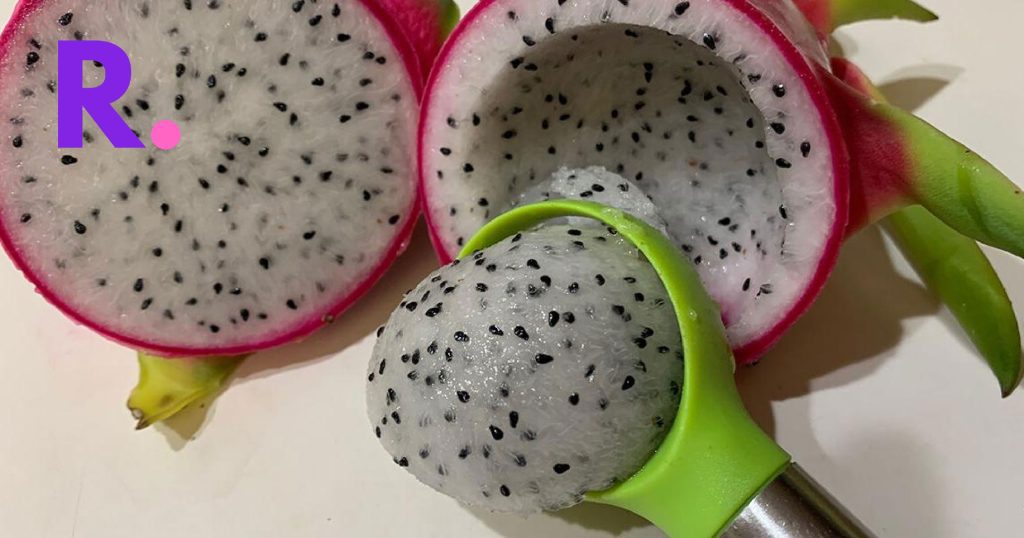
Serving Suggestions
You can enjoy dragon fruit in many ways after peeling it:
- Serve dragon fruit cold for a refreshing taste. Peeled and sliced fruit can be refrigerated for a nutritious snack.
- Add to fruit salads with some seasoning.
- Incorporate dragon fruit into smoothies with other tropical fruits and yoghurt for a healthful and creamy treat.
- Add dragon fruit to ice cream, sorbets, or panna cotta.
You can also view Yummy Dragon Fruit Recipe: A Delightful Dragon Fruit Smoothie Bowl
Dragon Fruit White: Uncommon Varieties
Lesser-Known White Dragon Fruit Varieties
- Hylocereus costaricensis: This Costa Rican pitaya or red-fleshed dragon fruit boasts brilliant pink to crimson flesh. It’s visually appealing and sweeter than white-fleshed.
- Hylocereus megalanthus: It is known as yellow dragon fruit or pitaya, has vivid yellow skin and white flesh. This kind tastes sweeter than the others.
- Hylocereus triangularis: Red pitaya, a red-skinned, white-fleshed dragon fruit, is sought after for its sweet and acidic taste. Less common but delicious.
Taste and Texture
- The Costa Rican Pitaya (Hylocereus costaricensis): It is a sweet variety with brilliant pink to scarlet flesh. A tropical delicacy, its flavour is like raspberries and watermelon.
- Yellow Dragon Fruit (Hylocereus megalanthus): Characterised by a gentle sweetness and resembling a kiwi-pear combination. In smoothies and sweets, its serves as a great addition.
- Red Pitaya (Hylocereus triangularis): A sweet and tart fruit with kiwi and grape flavors. This variety is popular for its vivid appearance and delicious taste.

FAQs
What are the health benefits of white dragon fruit?
White dragonfruit has many health benefits, such as:
- Vitamin C boosts immune system.
- High fiber content aids digestion and weight management.
- Antioxidants like betalains helps to reduce oxidative stress.
- B vitamins are critical for energy.
- Iron is important for red blood cell synthesis.
- Calcium supports bone health.
Can you eat dragon fruit seeds?
Dragon fruit seeds are safe to eat. They give the fruit a nice crunch and are nutritious.
Are white dragon fruit and pitaya the same thing?
Many call dragon fruit white pitaya blanca. Dragon fruit white is called “pitaya” among other Hylocereus fruits.
What does dragon fruit taste like?
Dragon fruit, white or pink, tastes like a kiwi and a pear. Sweet with a hint of acid.
How can I grow my own dragon fruit?
Growing dragon fruit at home requires a warm, tropical climate, well-drained soil, and a trellis or support structure for the climbing cactus. Growing dragon fruit cuttings requires frequent watering and plenty of sunlight.
Is dragon fruit good for weight loss?
Dragon fruit can aid weight loss and weight management. Its low calories and high fiber content helps in weight reduction. Additionally, its inherent sweetness reduces sugar cravings.
